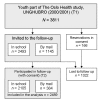Three-year follow-up of physical activity in Norwegian youth from two ethnic groups: associations with socio-demographic factors
- PMID: 19102770
- PMCID: PMC2640384
- DOI: 10.1186/1471-2458-8-419
Three-year follow-up of physical activity in Norwegian youth from two ethnic groups: associations with socio-demographic factors
Abstract
Background: More research on factors associated with physical activity and the decline in participation during adolescence is needed. In this paper, we investigate the levels, change, and stability of physical activity during the late teens among ethnic Norwegians and ethnic minorities, and we examine the associations between physical activity and socio-demographic factors.
Methods: The baseline (T1) of this longitudinal study included 10th graders who participated in the youth part of the Oslo Health Study, which was carried out in schools in 2000-2001. The follow-up (T2) in 2003-2004 was conducted partly at school and partly by mail. A total of 2489 (1112 boys and 1377 girls) participated both at baseline and at follow-up. Physical activity level was measured by a question on weekly hours of physical activity outside of school. Socio-demographic variables were collected by questionnaire and from data obtained from Statistics Norway. Analysis of variance was used to study the level of and changes (T1 to T2) in physical activity, and the associations between physical activity and socio-demographic factors. Stability in physical activity was defined as the percentage of students reporting the same physical activity both times.
Results: Boys were more active than girls at age 15 and 18 years, independent of ethnic background. Among girls, ethnic Norwegians were more active than ethnic minorities. Hours per week spent on physical activity declined in all groups during the follow-up period. Few associations were found between physical activity and socio-demographic factors in both cross-sectional and longitudinal data. Among the ethnic minority girls, 65% reported being physically active 0-2 hours per week at baseline, and 82% of these girls reported the same level at follow up.
Conclusion: The association between physical activity and ethnicity at age 15 years remained the same during the follow-up. Few associations were found between physical activity and socio-demographic variables. A large proportion of ethnic minority girls reported a persistently low physical activity level, and this low participation rate may need special attention.
Figures


References
Publication types
MeSH terms
LinkOut - more resources
Full Text Sources
Medical

